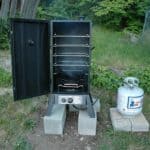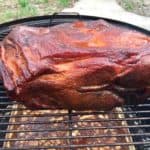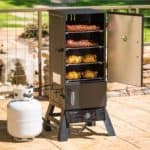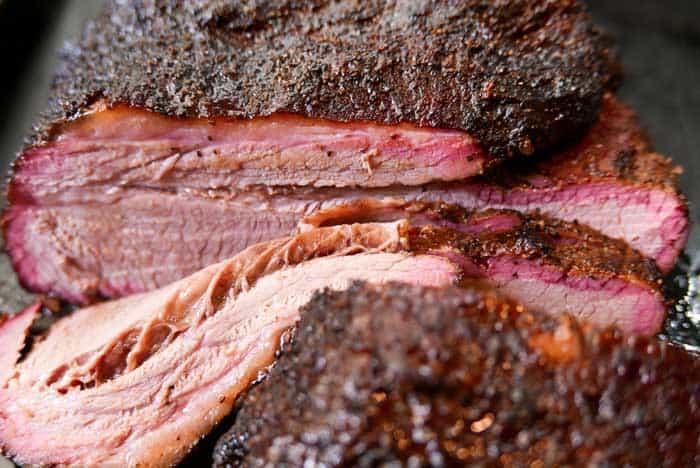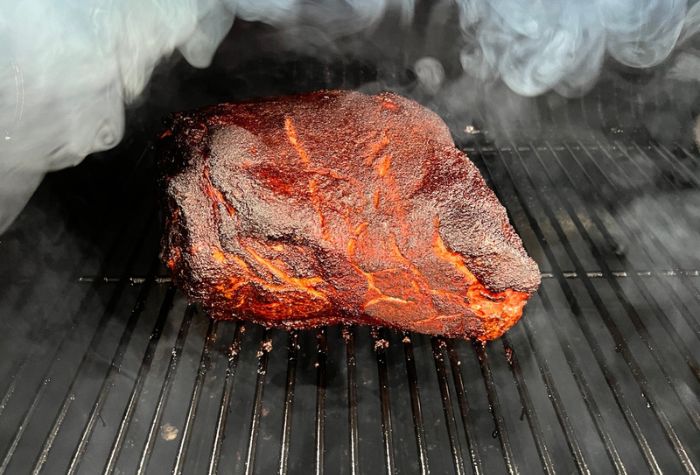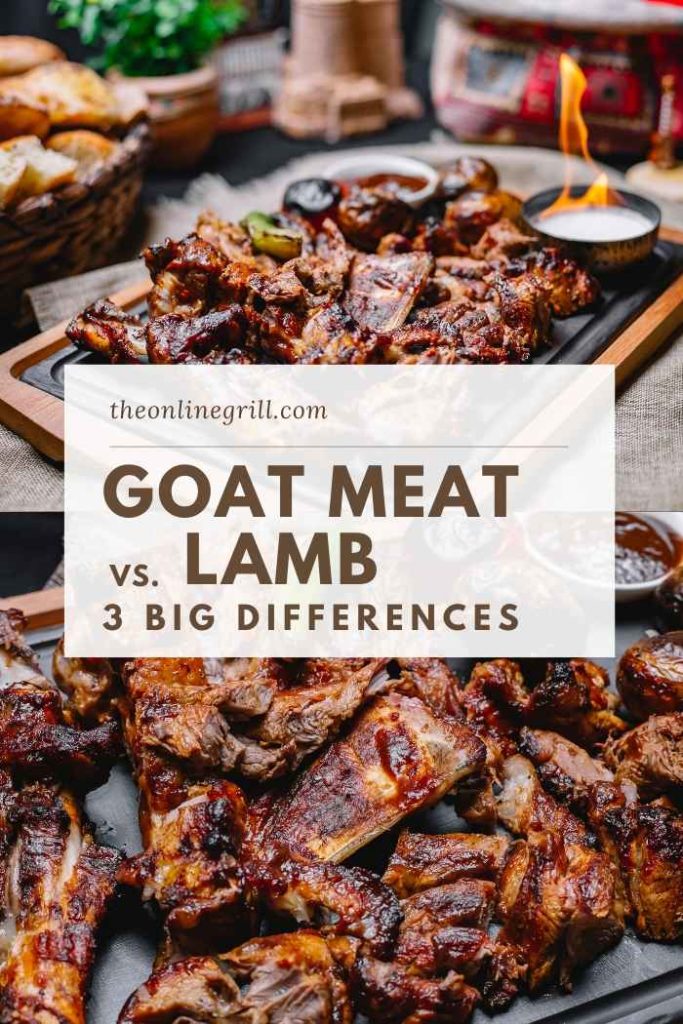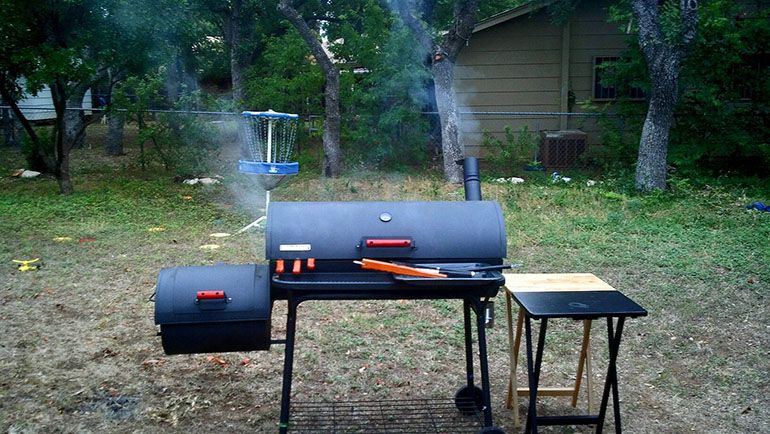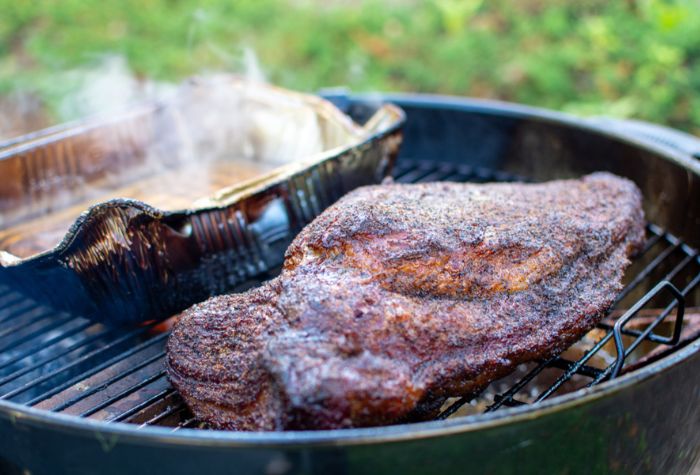Transform your backyard barbecue with our meat smoker guide. From charcoal offset smokers to electric and propane gas cookers, here’s what you need to know about the different types of smokers.
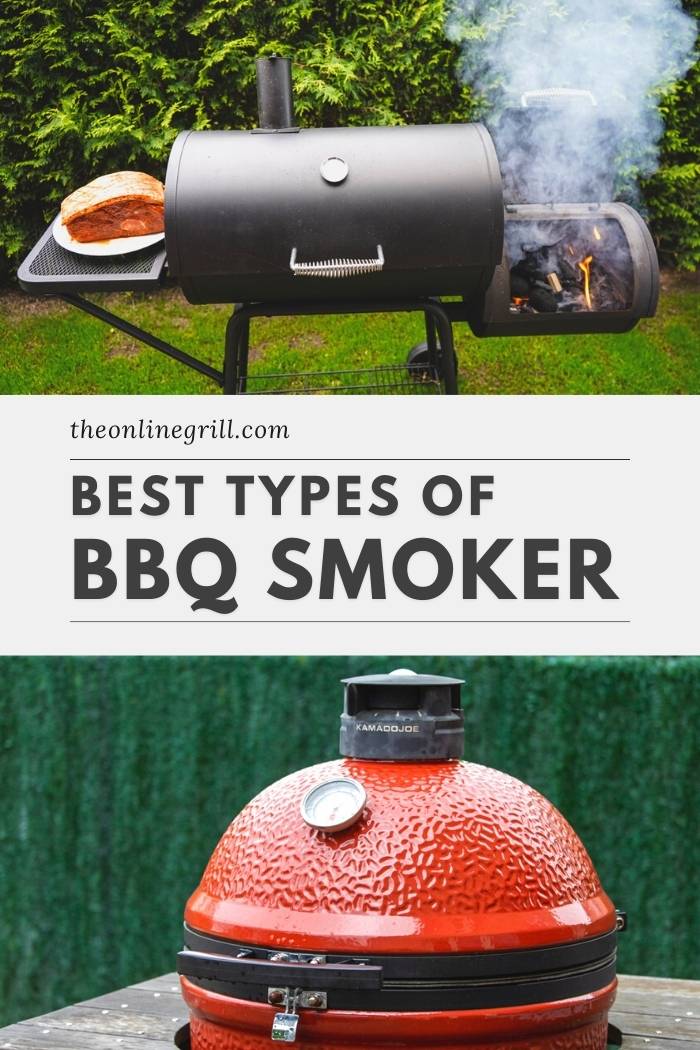
The right smoker can help to bring your barbecue to the next level by giving you tender, juicy cuts of meat that fall off the bone every time.
With so many different options to choose from, it’s not always easy to know which type of smoker will be the best fit for your backyard. Here, we’re going to go over the most popular smoker styles to give you a better idea of what might work for you.
What is a smoker?
Many people get smokers confused with barbecues, and it’s easy to see why. Both produce delicious, smoky cuts of meat using fuel sources such as charcoal, gas, or wood. However, grills and smokers function very differently.
While grills hold meat close to the heat source and sear it quickly, smokers allow heat to slowly pass over meat from afar. This makes each cut of meat even more tender than with grilling. Smoking can take a few hours to a few days, depending on what you’re cooking.
A smoker is designed to cook meat more slowly than a grill, and it holds cuts further away from the heat source. Some designs can function as both a grill and a smoker, depending on how you use them.
Different types of smokers use different types of fuels that can affect the taste, efficiency, and overall running costs for your smoker. The most common types of smoker fuels include:
- Propane or natural gas
- Electricity or solar
- Wood chips
- Charcoal lumps
- Manufactured pellets
Some smokers have a simple design that’s easy for beginners to master with just a shallow learning curve. Many use a “set it and forget it” approach so that you don’t have to babysit your meats. Others are better for experienced grillmasters and offer more precision and control over your cooking.
There are several different kinds of smokers to choose from depending on your budget, experience level, and the type of taste that you’re looking for. In this smoker comparison, we’re going to explore the most common types of smokers, how each works, and whether it might be the right option for you.
Offset smokers
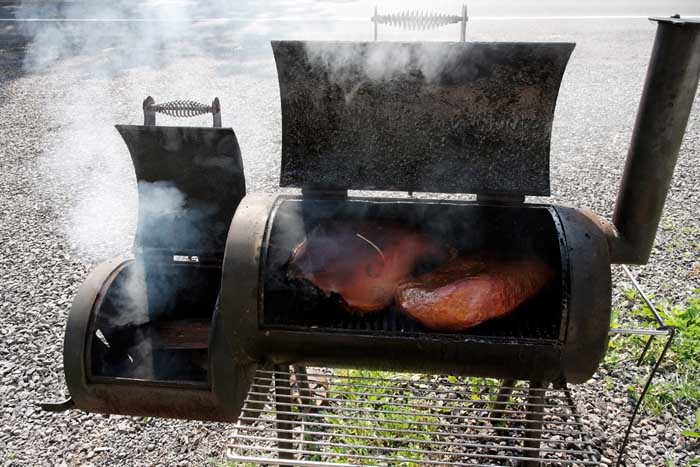
Offset smokers were first seen used by oilfield workers (source) out in rural areas of Texas. They would use old oil barrels to slowly smoke their meals, making for a delicious dinner at the end of a hard day’s work.
Nowadays, offset smokers have become somewhat more sophisticated, but they still require a skilled touch to master. You can find a wide range in quality when it comes to offset smokers, from flimsy, poorly insulated models to more expensive, high-quality options with thick walls and tight seals.
How they work
Offset smokers have two compartments that work together to create tender, flavorful dishes. The main cooking chamber is typically laid on its side, with one or more grates inside to increase the cooking area. A sealed door allows you to load and unload cuts of meat, while a smokestack allows for airflow and ventilation.
A smaller firebox is attached to the main cooking chamber, typically placed at a lower height to allow smoke to rise. You can use charcoal, wood chips, or even whole logs in some circumstances as a fuel source. In some designs, the firebox boasts a removable grill plate so that you can use the unit for both grilling and smoking.
With a high-quality smoker, the walls should be thick enough to maintain an even temperature. However, cheaper models that use thin, flimsy metal tend to lose heat quickly and can be difficult to control during cooking.
Who they’re perfect for
Offset smokers are one of the bulkiest designs available, so they’re not necessarily suitable for smaller yards and patios. You need a decent amount of space to operate an offset safely and comfortably, so this style is best for people with plenty of outdoor space to spare.
Offset smokers can also be more difficult to control than other styles such as electric or pellet models. They’re best for grill masters who are familiar with the art of smoking. Beginners may have trouble mastering the fine-tuning required to cook using an offset.
Pros
- Can cook massive amounts of meat
- High-end models are durable and efficient
- Some designs can function as both a grill and a smoker
Cons
- It can be difficult to control heat, even for smoking experts
- Many subpar models on the market
Drum smokers
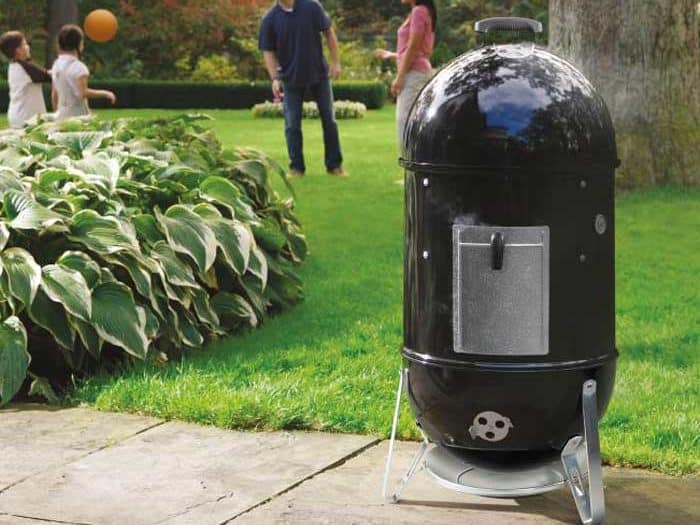
As one of the simplest smoker designs, drum smokers are affordable, easy to use, and are becoming increasingly popular in the smoker community. You can even find DIY kits that allow you to set up your own drum with little to no experience necessary.
How they work
Often called the Ugly Drum Smoker or UDS, this design has a very basic setup with just a single chamber for smoking. As the name suggests, it looks similar to an upright drum barrel. At the bottom of the container, a basket holds either charcoal or wood chips for fuel. About a foot above the heat source sits the grill grate, which will hold the cut of meat you’re cooking.
To use a drum smoker, simply add some charcoal or chips to the basket, then pile on some lit material. This will keep the heat at a low smolder, allowing you to slow cook your meal. You can also use drum smokers as a regular grill by adding a full basket of hot charcoal instead of just a few briquettes at a time.
Who they’re perfect for
Drum smokers are a good choice for grilling novices, as they have a simple design that’s easy to set up and use. What’s more, their insulated design means that you won’t have to worry too much about monitoring the heat source or adding more fuel.
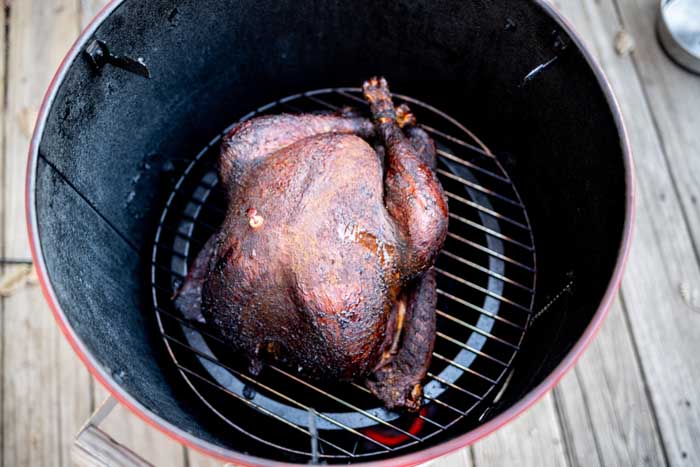
A typical drum smoker can hold around four pork shoulders at a time, making it an ideal size for families and smaller households. It can’t cook food in mass quantities, however. If you’re looking to cook a large amount of meat at once, an offset smoker or a large Kamado might make a better choice.
Drum smokers don’t offer as much control as some other styles, so they may not be the best style for grilling experts. It also isn’t the most attractive design, so it may not be the best option for those concerned with outdoor aesthetics.
Pros
- Simple and easy to use
- Functions as both a smoker and a grill
- You can build one yourself
Cons
- Not as attractive as other types of smokers
- Can only hold a small amount of food
Pellet smokers
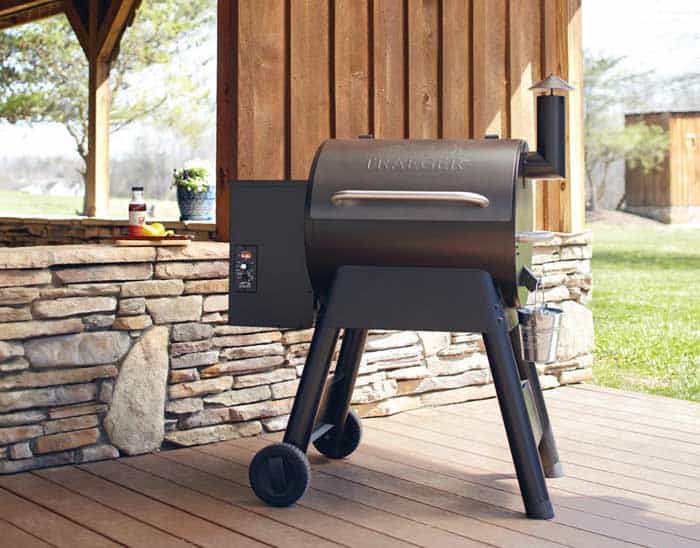
This is one of the most high-tech smoker options available on the market. Though it may look similar to other gas, electric, and charcoal models, pellet smokers use an entirely different fuel source to give your meat an even, smoky flavor.
How they work
Pellet smokers are another hands-off design that allows you to set a time, a temperature, and then forget about your food until it’s done cooking. Most run on electricity, making this a relatively efficient and eco-friendly option.
Instead of a traditional firebox for fuel, pellet grills boast a hopper that you load up with manufactured pellets. These pellets are made from compressed sawdust, and you can find them in a wide variety of wood flavors. Most people can’t taste the difference between meat cooked with wood chips and meat cooked with pellets.
From the hopper, an auger automatically deposits pellets into a firebox. A built-in thermostat tells the hopper how often to spit out pellets in order to maintain a constant temperature. Many have a digital display that lets you tweak settings with precision.
Who they’re perfect for
Pellet smokers are a relatively new addition to the grilling scene, but since their introduction, they’ve earned themselves a name as one of the most popular smoker styles. Both novices and experts can appreciate the fine level of precision and control that the hopper design gives you when cooking.
Pellet grills also offer the convenience of a “set it and forget it” approach, making them a good choice for the busy grill master. Most have a user-friendly display that allows you to set a constant temperature much more easily than you could by using vents and charcoal briquettes.
Pros
- High tech, hands-off design
- Uses eco-friendly and energy-efficient pellets instead of wood chips or charcoal
- Automatically maintains a constant temperature using a hopper system
Cons
- One of the most expensive smoker options
- Multiple parts and electronic systems can be prone to failure
Vertical smokers
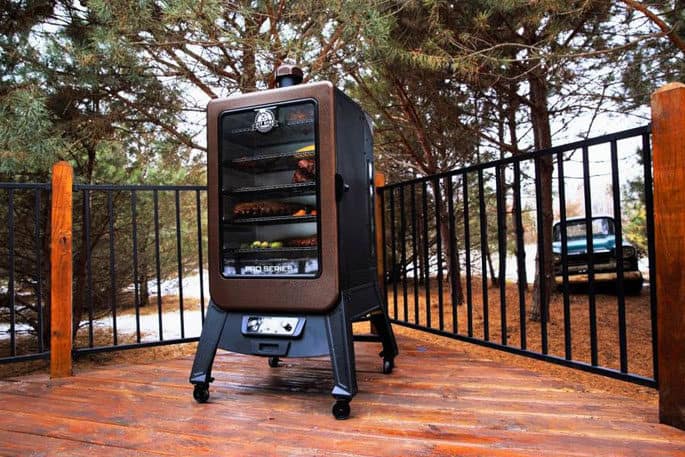
Also called vertical water smokers, this is one of the most popular types of smokers available on the market today. Bullet smokers are a common type of vertical smoker named for their sleek, bullet-shaped appearance. People from barbecue beginners to backyard grill masters favor this style of smoker because it’s compact, easy to use, and generally budget-friendly.
How they work
Vertical smokers have a relatively simple design that takes traps rising smoke in a single chamber to slowly cook meats to perfection. The heat most often comes from charcoal or wood chips located at the bottom of the smoker. However, if you want a more hands-off style, you can also find gas and electric models available.
Above the heat source sits a water pan. Not only does this help to temper the heat to keep things low and slow, but it also provides a moist cooking environment. This is crucial if you don’t want tender cuts of meat to dry out as they smoke.
At the very top of a vertical unit sits the main smoking chamber. This is where you’ll place the meats that you want to cook. Most of the time, a vertical smoker will offer one or more racks to give you more cooking space inside the chamber.
To keep air circulating, most vertical smoker models boast vents along both the cooking chamber’s top and bottom. This keeps meats from tasting too charred or smoky, and it gives you more control over temperature as you cook.
Who they’re perfect for
Vertical water smokers are ideal for those who are new to smoking meat. They have a simple, user-friendly design that’s easy to figure out and operate. Its compact design means that the smoker can fit on just about any patio or balcony.
If you’re eco-conscious, vertical smokers are also a good choice for your backyard. They have a relatively small carbon footprint, particularly gas or electric models. Thanks to their shape, vertical smokers consume fuel efficiently to release fewer pollutants into the air.
If you’re looking to feed a large group of people, a vertical smoker may not be the right choice for you. While you can find a wide range of different sizes, most are only suited to feed a large family. At most, you’ll be able to smoke around two to four pork shoulders or up to ten baby back ribs at a time.
Pros
- Compact, user-friendly design
- Eco-friendly operation
- Ideal for both beginners and experts alike
Cons
- Limited cooking capacity
- It can’t double as a grill
Electric smokers
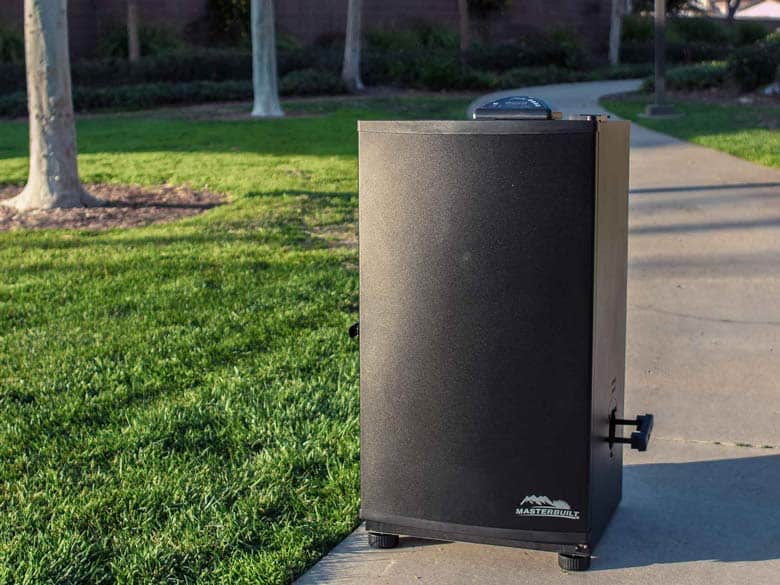
If you’re looking for a smoker that allows you to “set it and forget it,” then you might want to consider opting for an electric smoker. They don’t require you to add any fuel or babysit your meat. You can simply program it to the time and temperature you need and let it go. Thanks to their user-friendly and efficient design, electric smokers have gained popularity in recent years.
How they work
Instead of using fuel such as charcoal or gas, electric smokers have a heating element that must connect to a power source. High-end electric smokers also have a built-in thermostat to give you precise control over temperature. Some even have a digital display for effortless programming.
Above the heating element is a buffer that redirects radiant heat from the coil so that it doesn’t cook food too quickly. There’s also a pan for wood chips so that the heating element can create smoke to fill the chamber.
The meat itself rests on a grill rack in the upper smoking chamber. Larger models often boast a series of racks extending up the unit’s height to allow for more cooking space. High-end models are able to distribute heat and smoke evenly throughout the entire chamber.
Who they’re perfect for
Electric smokers are perfect for beginners looking for a foolproof way to get delicious, tender cuts of meat every time. They offer a foolproof way to maintain a constant temperature and ensure food cooks evenly.
For those concerned about environmental impact, electric smokers are more efficient than other styles such as charcoal. They also release fewer toxins in the air, making them a more eco-conscious choice for your backyard.
If you’re new to smoking meat, an electric unit is often a good place to start. It’s easy to program and gives you complete control over temperature. What’s more, it maintains heat automatically. You won’t have to worry about fine-tuning the temperature using vents and fuel.
At the same time, high-end electric smokers also make a great addition to any experienced grill master’s arsenal. They can offer the same smoky flavor as other wood chip smokers when used properly, but with a fraction of the work involved.
Pros
- Easy to use and program
- Environmentally friendly
- Ideal for both beginners and experts looking to “set it and forget it”
Cons
- It doesn’t hold up well against wind, weather, and wear-and-tear
- Requires access to an electrical outlet or battery bank
Propane gas smokers
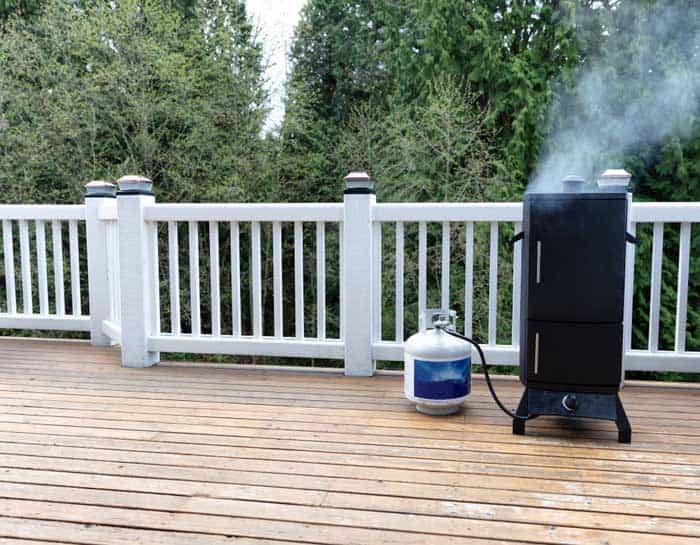
While similar in design to the electric smoker, propane smokers use a different fuel source. They’re another popular grill for beginners thanks to their user-friendly design, but often have a bit more of a learning curve than their electric cousins.
How they work
Like electric smokers, propane units have a heating element set into the bottom of the smoking chamber. Instead of being powered by a wall outlet or other electric power source, however, this type of smoker uses either natural gas or propane.
Above the heating unit, a buffer blocks too much radiant heat from searing meat, while a pan for wood chips or pellets releases smoke for flavor. The unit is sealed to ensure that meat is kept moist as it cooks.
Unlike electric smokers, propane units don’t usually have programmable features built-in. They most often have no internal thermostat but instead, rely on a display thermometer on the door to gauge temperature.
It can take some practice to reach the right cooking temperature and even more to maintain it. However, it’s easy to do with just the turn of a knob. Instead of adding fresh fuel or releasing excess heat through vents, you can turn the heating element up or down until you reach your desired cooking temperature.
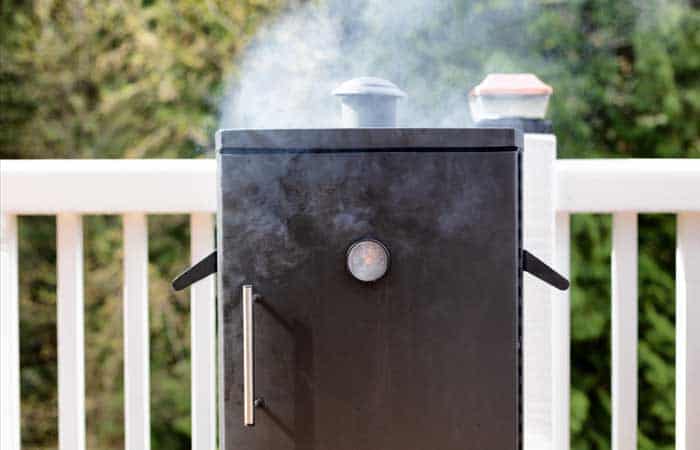
Who they’re perfect for
Propane grills are easy to find and relatively cheap, making them a popular choice amongst homeowners and casual grillers. Most also boast a user-friendly design, though there may be somewhat of a learning curve for beginners. They’re also eco-friendly, giving off less smoke and CO2 (source) than other styles of smokers.
You can find propane grills in all different shapes and sizes to meet your needs. Smaller units are ideal for families and households with limited space, while larger units may have the space to feed dozens of hungry diners.
While the unit itself is fairly inexpensive, it’s important to remember that it requires natural gas or propane as a fuel source. It can get expensive to keep the smoker topped off, especially if you don’t already have a gas line to your home.
Pros
- Inexpensive and easy to find
- It comes in a variety of different sizes
- Eco-friendly option
Cons
- Uses expensive propane or natural gas as a fuel source
- The learning curve for beginners
Kamado
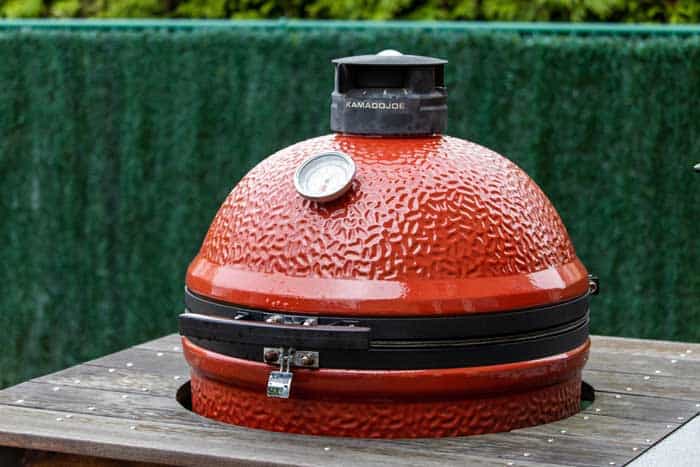
Also known as ceramic smokers, Kamado grills have been around since they were introduced by U.S. servicemen returning from Japan. While overseas, soldiers figured out how to convert traditional ceramic rice cookers into a makeshift grill. The Big Green Egg company adopted this design, which has been steadily gaining popularity since the 1970s.
Now, Kamado cookers come in all sorts of shapes and sizes to meet your unique grilling needs. The one feature that unites them is a thick ceramic shell that allows for superior insulation and airflow during cooking.
How they work
Kamado grills have a highly insulating ceramic exterior that allows you to maintain an even temperature for hours at a time. It boasts an efficient design that won’t waste any excess fuel, making it a fairly eco-friendly option. What’s more, it’s durable enough to withstand most wear-and-tear.
At the bottom of the Kamado’s cooking chamber sits a firebox that you can load with charcoal or wood chips. Above the fire, you can place a removable heat deflector that blocks direct radiant heat to keep cooking temperatures low. Your cut of meat will sit on a rack above this deflector.
Without the heat deflector, the surface of a Kamado can reach high temperatures of up to 700F. This means that it can function as a grill in addition to being a smoker, allowing you to sear meats and veggies for a similar smoky flavor.
Who they’re perfect for
While you can find budget Kamado options at many big box stores, you’ll get the best results with a quality grill manufactured by a reputable company such as Big Green Egg. A Kamado grill should be made of thick, high-quality ceramic and strong metal fastenings. Just to be safe, it’s a good idea to look for companies that back their product with an extended warranty.
Because this style of smoker is more expensive than other options, it’s best reserved for serious grillmasters. Kamado grills can also be difficult to control, making them a challenger for beginners. They take a long time to heat and cool, which can make for a steeper learning curve.
While most Kamado grills are designed to cook for a small family, you can also find larger options that can cook enough to feed dozens. It’s a good idea to think about who you plan to cook for before settling on what size Kamado to get.
Pros
- Can function as both a grill and a smoker
- Energy-efficient and low maintenance
- Durable design can withstand years of use
Cons
- More expensive than other smoker options
- Steep learning curve
Kettle grill
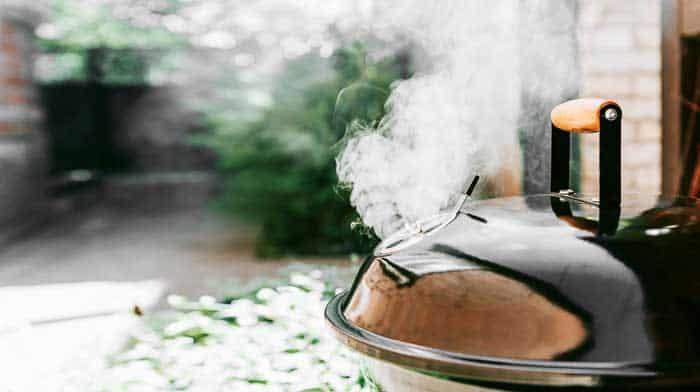
Most of us are familiar with the plain charcoal kettle grill. It’s a common fixture in plenty of yards and apartment complex balconies, with a compact shape and a simple, easy-to-use, and perhaps most importantly, affordable design.
What many people don’t know, however, is that the kettle grill can also be used as a smoker. You just have to know the right technique to end up with juicy, tender cuts of meat at the end of your cooking session.
How they work
Normally, kettle grills work by heating meat from below at a high temperature. Place burning charcoal into the bottom of the chamber, fit the grill grate on top, then place your meat on the grate for a delicious, smoky sear.
There are two ways that you can effortlessly convert your kettle grill into a smoker. Two-zone cooking is a good way to indirectly heat food for a low and slow cook instead of a quick sear. Just pile the charcoal briquettes on one side of the grill, add some lit material on top, and then maintain the temperature using the grill’s vent system.
The snake method of charcoal control gives you a bit more precision over the speed and intensity of your burn. Instead of piling charcoal into the grill haphazardly, you can line half of the grill’s edge with a small, neat ring of briquettes and then light for one end. This allows for a slow, controlled burn that can last for hours.
Who they’re perfect for
For people who already own a kettle grill, the two-zone or snake cooking method is the perfect introduction to the world of smoking. You won’t have to make any costly investments, and you’ll learn the basics of fuel control and temperature maintenance.
Even if you don’t already own a kettle grill, it makes an ideal choice for someone looking for a smoker-grill combo on a budget. Kettle grills offer the best of both worlds, and they’re compact enough to fit in most outdoor spaces. You can safely cook using a kettle grill even on apartment patios and balconies, provided it’s allowed in the rental agreement.
Keep in mind that it can be somewhat difficult for a novice to master the unique temperature control techniques needed to smoke with a kettle charcoal grill design. If you’re a beginner looking for your first smoker, you may want to opt for a more hands-off design, such as an electric or propane smoker.
Pros
- Budget-friendly option
- Works as both a grill and a smoker with the right technique
- It fits even in small spaces
Cons
- Limited cooking space
- Requires a somewhat complex technique to smoke

